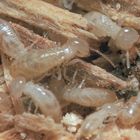For Better or for Worse Protozoan Relationships
Background

The relationship between 2 organisms can have varying degrees of association. In a commensal relationship, one organism is unharmed and the other benefits, e.g., the mealworm and gregarines. In a symbiotic relationship, 2 organisms form a partnership that can be (but isn’t always) beneficial to both. There are degrees of symbiosis, which range from a temporary association to one that persists from generation to generation, e.g., termites and their digestive tract protozoa.
Symbionts are sometimes so mutually dependent that they cannot exist separately, but more often there is a lack of cooperation between 2 organisms, resulting in parasitism. In parasitism, the parasite benefits at the expense of the host. Examples of this include 2 parasites that infect humans, causing serious diseases. The first, Plasmodium falciparum, causes malaria; and the second, Trypanosoma brucei, causes African sleeping sickness.
Probing into protozoan relationships
While you wouldn’t want your high schoolers studying dangerous parasites in live form, they can be safely studied with our Pathogenic Protozoa Slide Set. To study a living symbiotic relationship in your classroom, we recommend our Termite Study Kit. With it, students can study the relationship between diet and symbiosis and examine the protozoans, such as the flagellate Trichonympha, found in the digestive tracts of termites.
Your students can also study the digestive tract protozoa of termites using our Termite Digestive Symbionts and some basic equipment. Here’s how.
- Place a termite on a microscope slide.
- Use dissecting needles to separate the tip of the abdomen from the rest of the body. Be careful not to damage the gut.
- Place the hindgut (enlarged section) in a drop of 0.5% saline solution and tease it apart. Wash the protozoa free of the mucosa with a little more saline.
- Discard the gut, cover the protozoa with a cover glass, and examine them under a compound microscope.








